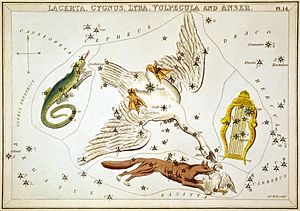Lacerta facts for kids
Lacerta is a small constellation in the northern sky. Its name means "the lizard" in Latin. Even though it's called the lizard, it is not very bright or easy to spot. It was created by a famous astronomer named Johannes Hevelius in the late 1600s. You can find Lacerta between some much brighter constellations like Cygnus, Andromeda, and Cassiopeia.
Contents
What is a Constellation?
A constellation is a group of stars that seem to form a pattern in the night sky. People from ancient times imagined these patterns looked like animals, objects, or heroes. They used constellations to tell stories, track the seasons, and navigate. Lacerta is one of the 88 modern constellations recognized today.
History of Lacerta
Who Discovered Lacerta?
The constellation Lacerta was first described by Johannes Hevelius. He was a Polish astronomer who lived in the 17th century. Hevelius created several new constellations to fill in what he called "empty" spaces on star maps. He published his star atlas, called Firmamentum Sobiescianum, in 1690. This book included Lacerta and other new constellations.
Why a Lizard?
Hevelius chose the name "Lacerta" because he wanted to name a constellation after a small, quick animal. He also considered names like "Reindeer" or "Scepter." The lizard was a good fit for this faint group of stars. It is a quiet corner of the sky, and the stars do not form a very clear shape.
Finding Lacerta in the Sky
Where is Lacerta Located?
Lacerta is located in the northern part of the sky. It is nestled between some well-known constellations. To its west is Cygnus (the Swan). To its east is Andromeda (the Princess). To the north, you will find Cassiopeia (the Queen). To the south, it borders Pegasus (the Winged Horse).
How to Spot the Lizard
Finding Lacerta can be a bit tricky because its stars are not very bright. The brightest star in Lacerta is called Alpha Lacertae. It is a blue-white star, but it is still quite faint. Some people say the constellation looks like a small, faint "W" shape, similar to Cassiopeia, but much smaller. The best time to look for Lacerta is during the autumn months in the Northern Hemisphere. You will need a dark sky away from city lights to see it clearly.
Stars and Objects in Lacerta
Main Stars of Lacerta
- Alpha Lacertae: This is the brightest star in the constellation. It is a hot, blue-white star located about 102 light-years from Earth.
- Beta Lacertae: This is the second brightest star. It is an orange giant star, much cooler and larger than Alpha Lacertae.
- Roe 47: This is a famous multiple star system. It means it is made up of at least five stars that appear close together in the sky. It is a fun target for small telescopes.
Deep-Sky Objects
Even though Lacerta is small and faint, it has some interesting deep-sky objects. These are objects beyond our solar system, like star clusters or galaxies.
- NGC 7243: This is an open cluster of stars. It is a group of young stars that formed from the same cloud of gas and dust. It looks like a small group of sparkling diamonds through a telescope.
- IC 5217: This is a planetary nebula. It is a cloud of gas and dust that was once the outer layers of a dying star. It looks like a faint, round glow.
See also
 In Spanish: Lacerta para niños
In Spanish: Lacerta para niños


